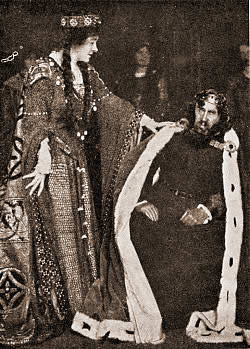 |
 |
||||||
| Synopsis by Arthur Robinson | ||
| Script: Web Page, PDF File [132Kb] | ||
| Reviews: | ||
| The Times, June 4th 1891 | ||
| The Times, April 28th 1892 | ||
| The Times, July 20th 1904 | ||
Synopsis

W.S. Gilbert's play Rosencrantz and Guildenstern first appeared in the periodical "Fun" in 1874, but was apparently not performed in public until 1891. A benefit performance in 1904 had a cast that included Gilbert himself, George Bernard Shaw, Francis Burnand, and Anthony Hope (author of "The Prisoner of Zenda", among other well-known works); an amateur performance in 1900 had featured P.G. Wodehouse as Guildenstern.
The main characters in Gilbert's play are King Claudius (while he has a secret sin, it is not having murdered his brother) and Queen Gertrude of Denmark, their son Hamlet, the courtiers Rosencrantz and Guildenstern, and Ophelia. Any resemblance between these characters and those in any other plays, living or dead, is, of course, purely coincidental.
The play opens with King Claudius of Denmark confessing (in blank verse) to his wife an indiscretion of his youth: he was once guilty of writing a five-act tragedy. But his play had a somewhat short run: it closed half-way through the first act as a result of hysterical laughter from the first-night audience. For the opening performance, Claudius had packed the theatre with sycophantic courtiers, but, he confesses, "My tragedy was more than even sycophants could stand." The humiliated Claudius then decreed that anyone who mentioned the play was to be executed.
Gertrude urges her husband to forget the past and concentrate on their present problem: young Hamlet's alarming "tendency to long soliloquy." She has summoned Rosencrantz and Guildenstern to distract their son's mind. Rosencrantz, it turns out, is in love with Ophelia, who tells him when he tells her, that she may not love him (just like Casilda may not love Luiz). She is betrothed to Hamlet, whose sanity is in doubt. For one thing, although he is an eleventh-century Dane, "he always dresses as King James the First". Opinion is divided on whether Hamlet is actually mad, but the favourite theory seems to be that "Hamlet is idiotically sane with lucid intervals of lunacy." She enters enthusiastically into Guildenstern's plan to break her unwanted engagement. He suggests that he and Rosencrantz trick Hamlet into putting on Claudius' "damned" tragedy and incurring the king's wrath. The only extant copy of the play, though, is in the possession of Ophelia's father, the Lord Chamberlain (the state censor). Ophelia is confident she can steal it that night, because, after spending the day "reading all the rubbishing new plays," her father always "sleeps exceeding sound".
In the second tableau, Rosencrantz and Guildenstern tell the Queen they plan to divert Hamlet by having him play a leading part in some court theatricals. Hamlet approaches, rumpling his hair and rolling his eyes. The horrified queen recognizes the symptoms: "That means — he's going to soliloquize!" She begs the others to prevent this. Hamlet enters and begins "To be — or not to be," but the others interrupt him, converting the soliloquy into a trio, in which they urge him to commit suicide. Finally, Hamlet rebukes them: "It must be patent to the merest dunce/Three persons can't soliloquize at once!" He retires up to finish uninterrupted, as a terrified Ophelia enters. It seems "the mouldy spectres of five thousand plays, all dead and gone" haunt her father's study, "chattering forth the scenes and parts of scenes [her] poor father had cut out." After that harrowing experience, she had concluded that, in cutting them, her father had aced most judiciously. But she was able to secure the fatal manuscript.
They then employ reverse psychology, showing Hamlet the five-act tragedy "Gonzago" (without revealing its authorship), but urging him not to put it on. Not only is it a poor play (Rosencrantz at one point calls it "a thing of shreds and patches") but, they tell him, it is too long, and all the parts are insignificant except his own: a mad Archbishop, who stabs his aunt for no discernible reason and enters upon a "career of murder, tempered by soliloquy" who is finally blown from a gun by the Bench of Bishops. Hamlet, however, is stagestruck, and insists on performing the tragedy.
In the third and last scene, the king and his court attend the performance; but in Gilbert's version, the play is a trap for Hamlet, not Claudius. Soon the audience is roaring with laughter, except for Claudius, who first comments that the lines seem familiar, then realizes the truth. The laughter continues until the audience learns that there are five acts to come, whereupon, according to the stage directions, "All groan." King Claudius then reveals that the play is his, and condemns both of his worthless children (Hamlet and the play) to death. Hamlet, as a philosopher, can't bear death. As the King draws his dagger, Ophelia suggests that, instead of killing the prince, the King should banish him to a "certain isle beyond the sea" called "Engle-land," where the natives are more likely to appreciate Hamlet. The King consents and sends Hamlet there with the comment, "They're welcome to his philosophic brain." So Hamlet gets deported, Rosencrantz gets Ophelia, and the play ends. So, presumably, does the revival of "Gonzago", which this time hasn't even made it to the middle of Act I.
This article appeared in Issue 39 (July 1993) of Precious Nonsense, the newsletter of the Midwestern Gilbert & Sullivan Society. Posted by permission of Sarah Cole, Society Secretary/Archivist. For information on Society membership write to: The Midwestern Gilbert & Sullivan Society, c/o Miss Sarah Cole, 613 W. State St., North Aurora, IL 60542-1538.
Page modified 19 December 2009